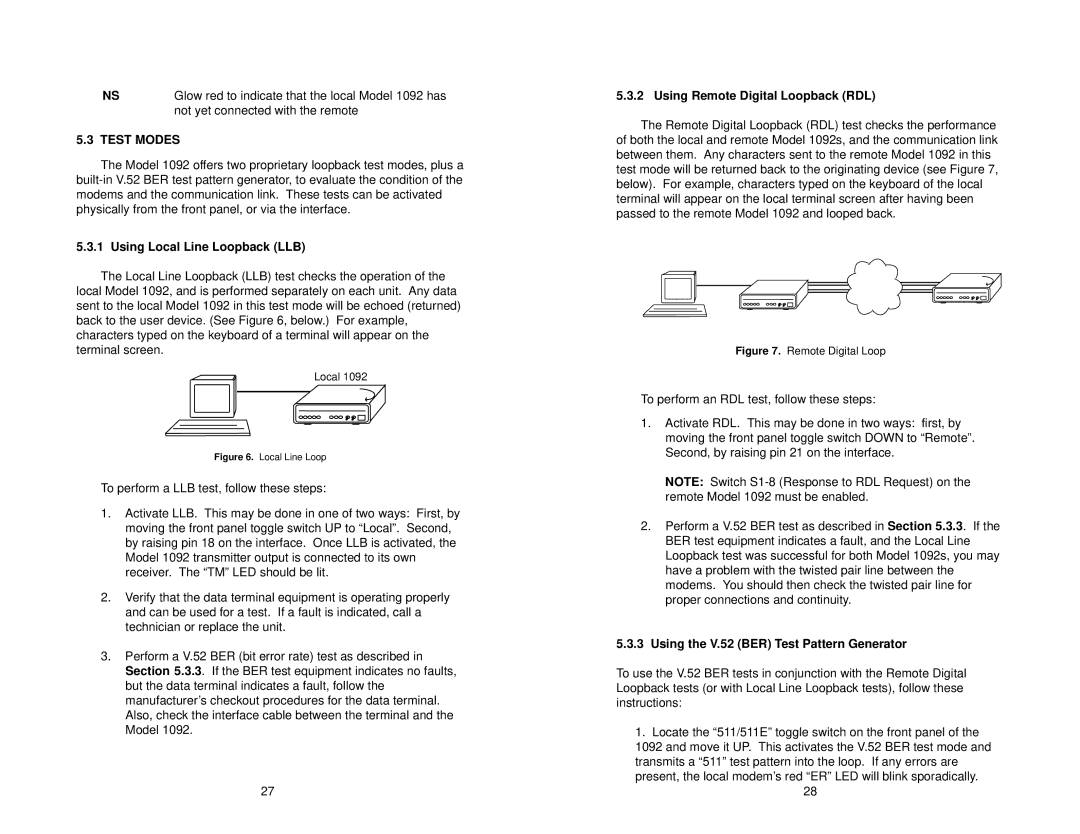
NS | Glow red to indicate that the local Model 1092 has |
| not yet connected with the remote |
5.3 TEST MODES
The Model 1092 offers two proprietary loopback test modes, plus a
5.3.1 Using Local Line Loopback (LLB)
The Local Line Loopback (LLB) test checks the operation of the local Model 1092, and is performed separately on each unit. Any data sent to the local Model 1092 in this test mode will be echoed (returned) back to the user device. (See Figure 6, below.) For example, characters typed on the keyboard of a terminal will appear on the terminal screen.
Local 1092
Figure 6. Local Line Loop
To perform a LLB test, follow these steps:
1.Activate LLB. This may be done in one of two ways: First, by moving the front panel toggle switch UP to “Local”. Second, by raising pin 18 on the interface. Once LLB is activated, the Model 1092 transmitter output is connected to its own receiver. The “TM” LED should be lit.
2.Verify that the data terminal equipment is operating properly and can be used for a test. If a fault is indicated, call a technician or replace the unit.
3.Perform a V.52 BER (bit error rate) test as described in Section 5.3.3. If the BER test equipment indicates no faults, but the data terminal indicates a fault, follow the manufacturer’s checkout procedures for the data terminal. Also, check the interface cable between the terminal and the Model 1092.
27
5.3.2 Using Remote Digital Loopback (RDL)
The Remote Digital Loopback (RDL) test checks the performance of both the local and remote Model 1092s, and the communication link between them. Any characters sent to the remote Model 1092 in this test mode will be returned back to the originating device (see Figure 7, below). For example, characters typed on the keyboard of the local terminal will appear on the local terminal screen after having been passed to the remote Model 1092 and looped back.
Figure 7. Remote Digital Loop
To perform an RDL test, follow these steps:
1.Activate RDL. This may be done in two ways: first, by moving the front panel toggle switch DOWN to “Remote”. Second, by raising pin 21 on the interface.
NOTE: Switch
2.Perform a V.52 BER test as described in Section 5.3.3. If the BER test equipment indicates a fault, and the Local Line Loopback test was successful for both Model 1092s, you may have a problem with the twisted pair line between the modems. You should then check the twisted pair line for proper connections and continuity.
5.3.3Using the V.52 (BER) Test Pattern Generator
To use the V.52 BER tests in conjunction with the Remote Digital Loopback tests (or with Local Line Loopback tests), follow these instructions:
1.Locate the “511/511E” toggle switch on the front panel of the 1092 and move it UP. This activates the V.52 BER test mode and transmits a “511” test pattern into the loop. If any errors are present, the local modem’s red “ER” LED will blink sporadically.
28
